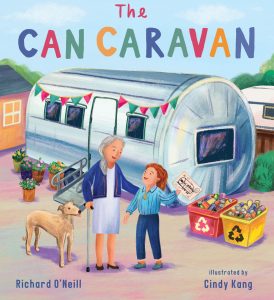 The Can Caravan
The Can Caravan
Written by Richard O’Neill
Illustrated by Cindy Kang
Child’s Play, 2022, pp. 32 (unpaged)
ISBN: 978-1786286154
Janie, a young, inventive girl, undertakes a huge recycling project to help a member of her Romani community in the UK. As the story begins, we are introduced to Janie, who appears to share close relationships with people in her community. Janie’s class will be going on a field trip to a recycling plant soon, and Janie enthusiastically shares her Romani perspective on recycling. When her neighbor, Mrs. Tolen, breaks her hip and ends up in the hospital, Janie learns that Mrs. Tolen can’t return to her caravan until it passes an inspection by social services. She takes it upon herself to find a way to restore Mrs. Tolen’s caravan. Janie enlists the help of her class and family to initiate a recycling project to collect aluminum cans which they can trade for sheets of aluminum to restore the caravan. She even seeks out the social worker assigned to Mrs. Tolen’s case and asks him to secretly inspect the aluminum caravan to help surprise Mrs. Tolen. The whole community and Janie’s class show up to surprise Mrs. Tolen with her new home, the world’s first Can Caravan! The book ends with additional material about the step-by-step process of aluminum recycling and some interesting facts about aluminum.
The Can Caravan is full of inclusivity and positive representations. The characters include Janie’s male teacher and his husband, a classmate who is a wheelchair user, classmates and family members wearing turbans and hijabs, and senior characters with mobility aids. Power relationships are also well balanced, as Janie is the one taking on a managerial role in the restoration project. There are also positive relationships between younger and senior characters portrayed through Janie and Mrs. Tolen’s friendship, as well as Janie’s relationship with her grandad.
Some significant details can also be observed through the illustrations, which reveal aspects about Romani culture. These include hidden items like Mrs. Tolen’s horse locket on the bedside table when she is in the hospital, Janie’s mother’s arm tattoo, and the golden horseshoe rings Janie’s mother and grandfather wear. Not-so-hidden is the representation of the caravan life style and the use of Romani terms, for which the author provides a glossary at the front of the book.
While visually the story is inclusive and vibrant, it neglects to invite the reader into the character’s cultural experiences. This is because the primary purpose of this story is not to invite readers into Romani culture, but to educate on recycling and community action. There seems to be a significant connection between Romani culture and recycling, referred to by the grandfather as “rag-and-bone” trade; however, because the focus is split between taking global climate action and the Romani life experiences, the latter gets overshadowed. This is apparent through the explicit focus on community action, showing Janie as she advocates for Mrs. Tolan by holding lectures, going door-to-door, and posting online videos as a call to action. In contrast, details about Romani culture are hidden in the illustrations, rather than explicitly addressed. The few times Romani experiences become significant in the story is the use of occasional Romani terms, or when Janie shares the historical connection between Romani people and recycling. In addition, we are distanced from the character’s cultural experience by the third-person voice and the simplistic art style for characters who never make eye-contact with the reader. This is a well-told story about a young person who leads a community project and happens to be Romani, rather than the story of a Romani community activist.
This book would fit well in a text set with O’Neill’s other books of Romani characters and could also be paired with a non-fiction text like A History of The Romani People (2005) by Hristo Kyuchukov and Ian Hancock to gain deeper understanding of the Romani people, their history, and their culture.
The author, Richard O’Neill, is a sixth-generation storyteller who was raised in a fully nomadic Romani family, traveling between Northern England and Scotland. O’Neill describes himself as an activist of Romani and Gypsy culture and advocates for positive education, interaction, and inclusion of Romani people. He has published multiple children’s picturebooks, all featuring Romani characters or telling stories of Romani people. His works include The Lost Homework (2019), illustrated by Kristi Beautyman, and Polonius the Pit Pony (2018) illustrated by Feronia Parker Thomas. He has also published folktales, co-authored with Katherine Quarmby, such as Yokki and the Parno Gry (2016), illustrated by Marieke Nelissen, and Ossiri and the Bala Mengro (2016), illustrated by Hannah Tolson. O’Neill’s children’s books are published by Child’s Play Ltd., both in the UK and the US. Online resources for information about O’Neill include: https://literacytrust.org.uk/storytellers-and-authors/find-uk-storytellers-authors/richard-oneill/ and http://www.romaniarts.co.uk/richard-oneill-storyteller-author-playwright/
Cindy Kang is a New York-based Korean illustrator. Her other notable contributions to children’s literature include the art for King Sejong Invents an Alphabet (2021). Kang paints an entire world in this picturebook where every single detail, from the background characters to the jewelry, are thoughtfully designed and placed to create a vibrant community and add depth to the story. Her work can be explored on her website.
Alisa Kaiser, University of Arizona, Tucson
© 2022 by Alisa Kaiser

